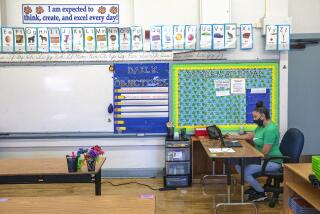Offspring Can Succeed PC-Less, but If You’re Looking . . .
- Share via
Every few months when I was growing up, my family would receive a visit from a door-to-door encyclopedia salesman who would try to convince my parents that his set of books was the key to their children’s success in school and later life. They bought a set in 1955, and although we all did pretty well in school, I suspect we would have done OK even without that leather-bound 21-volume set that’s still in pristine condition.
Today, it’s the home computer that is supposed to put your children on the information superhighway so they can cruise right to the front of the class. Although having a PC at home can help children with their homework and perhaps help stimulate some of their thought processes, a machine is not going to turn a dullard into a rocket scientist or a reluctant student into a dedicated scholar.
And believe it or not, it’s still possible for a bright and motivated child in a supportive family and school to succeed without a PC at home.
That doesn’t mean kids don’t need access to computers. Personal computers are as much an educational tool today as the typewriter and slide rule were 30 years ago, but in most communities kids can use machines at schools or at public libraries if there isn’t one at home.
Nevertheless, having a PC at home is certainly a lot more convenient. But that still doesn’t mean that each kid in the family needs to have his or her own brand-new, state-of-the-art PC.
My kids use a 3-year-old 33-megahertz 486 machine equipped with 8 megabytes of RAM, Windows 3.1, a relatively small (200-megabyte) hard disk and a two-speed CD-ROM drive. Such a machine on the used market is worth about $850, according to Chet Milensky, manager of American Computer Exchange ([800] 786-0717), a used-computer brokerage firm that links sellers and buyers. You might find one even cheaper through the classifieds.
I know families whose kids are churning out homework on old Mac SE/30 machines or now-obsolete 386 or 286 MS-DOS systems. If you’re going to buy a used machine, though, try to get one with a 486 Intel CPU or a Mac with at least a Motorola 68030 microprocessor. These machines can run virtually all of the latest software.
I sometimes work with a 66-MHz 486 machine with 12 megabytes of memory. It’s a little slow but more than adequate for homework, office use and most multimedia titles.
A used Macintosh SE 30, which is able to run most current Mac programs, albeit in black and white, goes for between $400 and $500, according to Milensky. Five or six hundred dollars will get you a 33-MHz 486 PC clone with a color monitor but no sound card or CD-ROM drive. A multimedia Macintosh Quadra 610 with a monitor goes for about $800. Used Macs with PowerPC chips start at about $1,000, according to Milensky. Used 486 notebook computers--popular on college campuses--also start at about $1,000.
Before paying for a used machine, inspect it carefully to make sure all systems are working properly. Although anything is possible, of course, a machine that works right when you buy it is likely to keep working. If you don’t feel qualified to judge the machine yourself, bring a knowledgeable friend along to put it through its paces, or take it to a dealer to have it checked out by a technician.
In addition to brokers and the classifieds, you can also find used computers in some computer stores. Or ask around at work. Some companies sell off equipment to their employees at bargain-basement prices.
In the best of all worlds, you’d have a new machine with a four-speed or higher CD-ROM drive, a 28.8-kbps modem, 16 megabytes of memory, a gigabyte (1,000 megabytes) hard drive and a Pentium or PowerPC central processing chip. But not all families can afford the $1,500 to $2,000 for the machine plus $300 to $500 for a color inkjet printer.
Don’t feel that you have to have a name-brand machine. Yes, companies such as Compaq, IBM and Hewlett-Packard offer good warranties, but many small computer dealers can often custom-build you a quality machine for less. Check out mail-order houses such as Gateway 2000, Micron and Dell. All the computer magazines are brimming with ads for these and other companies.
If the world were a perfect place, I’d recommend notebook computers for all high school and college students because these can be carried to class and the library. As it is, though, such machines are easily lost, stolen or broken, so it’s not a good idea unless your offspring are exceptionally careful with their possessions.
Many college students, according to Milensky, opt for used notebook computers, which can sometimes be found for less than $1,000. If you do purchase a notebook, be sure it’s covered by your home insurance policy.
Before buying any computer or software for a college student, check with the campus store or computer center to see if it offers a special discount.
When deciding between a PC and a Macintosh, consider the support available. Although some colleges (and a few private schools) encourage students to use one or the other type of machine, it generally won’t matter.
Lawrence J. Magid can be reached at magid@latimes. His World Wide Web page is at https://www.larrysworld.com
More to Read
Inside the business of entertainment
The Wide Shot brings you news, analysis and insights on everything from streaming wars to production — and what it all means for the future.
You may occasionally receive promotional content from the Los Angeles Times.








